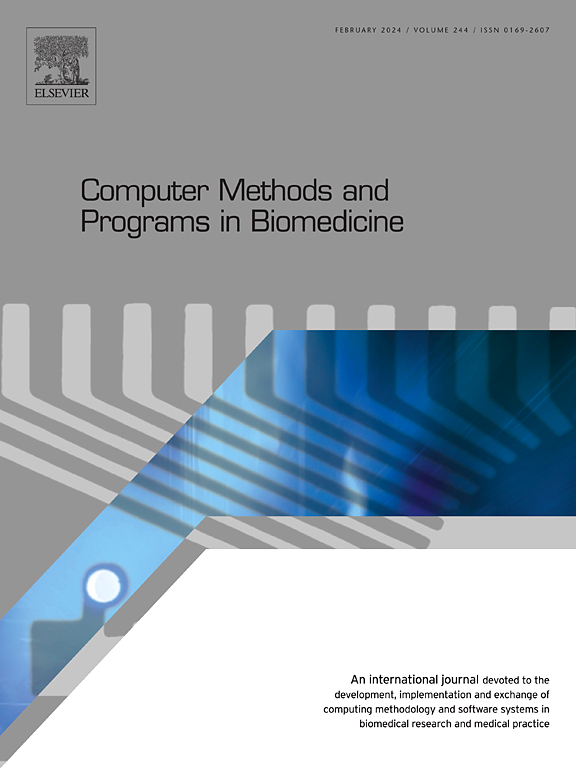一种基于特征点检测的PET心肌灌注成像定量分析方法
IF 4.9
2区 医学
Q1 COMPUTER SCIENCE, INTERDISCIPLINARY APPLICATIONS
引用次数: 0
摘要
目的对心脏正电子发射断层扫描(PET)图像进行轴向定向分析是心脏正电子发射断层扫描(PET)图像分析的关键。本研究旨在设计一种自动重定向卷积神经网络(CNN),并评估其泛化性。方法提出一种结合U-Net和可微空间-数值变换模块(DSNT-U)的人工智能(AI)方法,自动定位三个特征点(Papex、Pbase和PRV),并由经验丰富的放射科医生手动定位这三个特征点作为参考标准(RS)。另一名放射科医生进行手动定位以进行再现性评估。DSNT-U最初在[11C]醋酸数据集(训练/测试:40/17)上进行训练和测试,并进一步与cnn -空间变压器网络(CNN-STN)进行比较。在一个[13N]氨数据集(n = 30)上对4个被试进行微调后的网络进行测试。通过坐标、体积和定量指标(药代动力学参数和总灌注缺陷)评价DSNT-U的性能。结果DSNT-U成功实现了[11C]醋酸和[13N]氨数据集的自动心肌定向。对于前者数据集,DSNT-U预测的坐标与RS之间的类内相关系数(ICCs)超过0.876。基于dsnt - u重新定位获得的短轴(SA)图像与参考SA图像的平均归一化均方误差(NMSE)为0.051±0.043。在药动学参数方面,DSNT-U与RS的R²均大于0.968。与CNN-STN相比,DSNT-U在估计的刚性变换参数与RS之间显示出更高的ICC,在[13N]氨数据集上进行微调后,DSNT-U重新定向的SA图像与参考SA图像之间的平均NMSE为0.056±0.046。dsnt - u衍生图像计算的TPD值与参考值之间的ICC为0.981。此外,在不同性别或不同心肌灌注缺陷(MPD)状态的受试者中,DSNT-U预测的表现没有显著差异。结论DSNT-U能够在[11C]乙酸数据集上准确定位Papex、Pbase和PRV。经过微调后,定位模型可以应用于[13N]氨灌注数据集,具有良好的泛化性能。该方法可以适应不同性别(带或不带MPD)和不同示踪剂的数据,显示出替代人工操作的潜力。本文章由计算机程序翻译,如有差异,请以英文原文为准。

A myocardial reorientation method based on feature point detection for quantitative analysis of PET myocardial perfusion imaging
Objective
Reorienting cardiac positron emission tomography (PET) images to the transaxial plane is essential for cardiac PET image analysis. This study aims to design a convolutional neural network (CNN) for automatic reorientation and evaluate its generalizability.
Methods
An artificial intelligence (AI) method integrating U-Net and the differentiable spatial to numeric transform module (DSNT-U) was proposed to automatically position three feature points (Papex, Pbase, and PRV), with these three points manually located by an experienced radiologist as the reference standard (RS). A second radiologist performed manual location for reproducibility evaluation. The DSNT-U, initially trained and tested on a [11C]acetate dataset (training/testing: 40/17), was further compared with a CNN-spatial transformer network (CNN-STN). The network fine-tuned with 4 subjects was tested on a [13N]ammonia dataset (n = 30). The performance of the DSNT-U was evaluated in terms of coordinates, volume, and quantitative indexes (pharmacokinetic parameters and total perfusion deficit).
Results
The proposed DSNT-U successfully achieved automatic myocardial reorientation for both [11C]acetate and [13N]ammonia datasets. For the former dataset, the intraclass correlation coefficients (ICCs) between the coordinates predicted by the DSNT-U and the RS exceeded 0.876. The average normalized mean squared error (NMSE) between the short-axis (SA) images obtained through DSNT-U-based reorientation and the reference SA images was 0.051 ± 0.043. For pharmacokinetic parameters, the R² between the DSNT-U and the RS was larger than 0.968. Compared with the CNN-STN, the DSNT-U demonstrated a higher ICC between the estimated rigid transformation parameters and the RS. After fine-tuning on the [13N]ammonia dataset, the average NMSE between the SA images reoriented by the DSNT-U and the reference SA images was 0.056 ± 0.046. The ICC between the total perfusion deficit (TPD) values computed from DSNT-U-derived images and the reference values was 0.981. Furthermore, no significant differences were observed in the performance of the DSNT-U prediction among subjects with different genders or varying myocardial perfusion defect (MPD) statuses.
Conclusions
The proposed DSNT-U can accurately position Papex, Pbase, and PRV on the [11C]acetate dataset. After fine-tuning, the positioning model can be applied to the [13N]ammonia perfusion dataset, demonstrating good generalization performance. This method can adapt to data of different genders (with or without MPD) and different tracers, displaying the potential to replace manual operations.
求助全文
通过发布文献求助,成功后即可免费获取论文全文。
去求助
来源期刊

Computer methods and programs in biomedicine
工程技术-工程:生物医学
CiteScore
12.30
自引率
6.60%
发文量
601
审稿时长
135 days
期刊介绍:
To encourage the development of formal computing methods, and their application in biomedical research and medical practice, by illustration of fundamental principles in biomedical informatics research; to stimulate basic research into application software design; to report the state of research of biomedical information processing projects; to report new computer methodologies applied in biomedical areas; the eventual distribution of demonstrable software to avoid duplication of effort; to provide a forum for discussion and improvement of existing software; to optimize contact between national organizations and regional user groups by promoting an international exchange of information on formal methods, standards and software in biomedicine.
Computer Methods and Programs in Biomedicine covers computing methodology and software systems derived from computing science for implementation in all aspects of biomedical research and medical practice. It is designed to serve: biochemists; biologists; geneticists; immunologists; neuroscientists; pharmacologists; toxicologists; clinicians; epidemiologists; psychiatrists; psychologists; cardiologists; chemists; (radio)physicists; computer scientists; programmers and systems analysts; biomedical, clinical, electrical and other engineers; teachers of medical informatics and users of educational software.
 求助内容:
求助内容: 应助结果提醒方式:
应助结果提醒方式:


